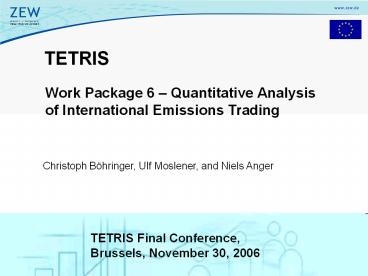PowerPoint-Pr - PowerPoint PPT Presentation
Title:
PowerPoint-Pr
Description:
TETRIS Work Package 6 Quantitative Analysis of International Emissions Trading Christoph B hringer, Ulf Moslener, and Niels Anger TETRIS Final Conference, – PowerPoint PPT presentation
Number of Views:80
Avg rating:3.0/5.0
Title: PowerPoint-Pr
1
TETRIS
Work Package 6 Quantitative Analysisof
International Emissions Trading
Christoph Böhringer, Ulf Moslener, and Niels
Anger
TETRIS Final Conference, Brussels, November 30,
2006
2
Objectives
- Develop macroeconomic model (computable general
equilibrium CGE) of international trade and
energy use featuring the EU ETS in 2010 - Integrate project-based JI and CDM within
top-down CGE framework accounting for - Transaction costs
- CDM-specific investment risks
- Technology transfer
- Quantitative assessment of economic and emission
impacts triggered by climate policies
Workpackage leader
- ZEW
- Ecoplan
- CCAP
- ECN
- NTE
Workpackage participants
3
Model inputs
- GTAP 6 database, EU and DOE energy projections to
2010 - EU-27 allowance allocation NAP II
- Project-based CDM cost and potential (work
package 2 and 3) - Project-based transaction costs (work package 3)
- Premium on CER price
- Upward shift of CDM supply curve
- Composite investment risk indicator (work package
1) - Risk premium on CER price
- Upward shift of CDM supply curve risk lowers
expected return of CDM projects
4
Implementation of bottom-up CDM supply function
(including transaction costs and risk)
Key MAC marginal abatement cost, TC
transaction costs, R investment risk
5
General Equilibrium Model PACE
PACE (Policy Assessment based on Computable
Equilibrium)
- Multi-sector, multi-region model of the global
economy - Incorporation of market interactions and income
closures - Calibration of technologies and preferences based
on empirical data
6
Model regions
EU-27 Member States
Rest of ratifying Annex B parties Russian Federation Rest of Former Soviet Union Japan Canada
CDM host countries China incl. Hong Kong India Rest of East South Asia Brazil Central South America South Africa
7
Climate policy scenarios
Central scenario dimensions
Scenario Regulatory scheme CDM access Transaction costs Investment risk
ET Emissions trading No No No
ET_CDM Emissions trading Yes No No
ET_CDM_TC_R Emissions trading Yes Yes Yes
Key ET emissions trading, TC transaction
costs, R investment risk
Additional scenario dimensions
- No Hot Air (No Hot Air supply from FSU)
- Additionality (Restricted CDM projects)
- Supplementarity (Limit on CER imports)
Permit supply and demand restrictions
8
International CO2 permit price (US/t CO2)
Key HA hot air, Add additionality
9
Sensitivity analysis for CO2 permit price
Illustration Scenario ET_CDM_TC_R withouthot
air ? CO2 price 0.98 US/tCO2)
max1.44
90 quantile 1.32 US/tCO2
Technique Monte-Carlo simulations on
key elasticities
Mean 1.054
Median 0.98
10 quantile 0.89 US/tCO2
min0.83
10
Emission reduction of EU-27 ( vs. BAU)
Key HA hot air, Add additionality, Supp
supplementarity
11
Welfare loss for EU-27 ( change in equivalent
variation)
Key HA hot air, Add additionality, Supp
supplementarity
12
Implementation of projects
- Implementation of CDM projects based on numerical
simulation results - Procedure (linkage of model and CDM database)
- Simulation of CO2 permit prices for alternative
policy scenarios - Derivation of marginal abatement cost levels on
the project-based CDM supply curves (CDM
database) - Identification of implemented projects (number /
volume) within the CDM database
13
Implemented CDM projects (volume share by region)
No CDM restriction
Additionality
CDM Potential
14
Conclusions (1)
- Low permit price and small macroeconomic impacts
due to large - potentials of cheap CDM permit supply
- Given prices for CER futures Hidden costs of
CDM investments? - Transaction costs and investment risk increase
permit price, but - limited impact on the macroeconomy based on
underlying CDM data - Large impact of Additionality criterion,
Supplementarity rule - and restriction of Hot-Air on permit price
and adjustment costs
15
Conclusions (2)
- China, CentralSouth America and Rest of East
South Asia - as dominant CDM host regions. Sectoral
distribution dominated - by Electricity, Agricultural Products and
Public Sector - Additionality criterion decreases number volume
and distribution - of CDM projects significantly ? exclusion of
No-Regret options - Transaction costs and investment risk deter
implementing CDM projects, - and change project portfolio in favor of
large-scale options
16
TETRIS
Work package 6 Quantitative Analysisof
International Emissions Trading
Christoph Böhringer, Ulf Moslener and Niels Anger
TETRIS Final Conference, Brussels, November 30,
2006

